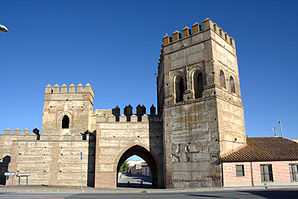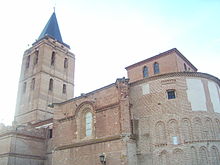Madrigal de las Altas Torres
| Madrigal de las Altas Torres municipality | ||
|---|---|---|
 City walls and city gate of Madrigal de las Altas Torres
|
||
| coat of arms | Map of Spain | |

|
|
|
| Basic data | ||
| Autonomous Community : | Castile and Leon | |
| Province : | Ávila | |
| Comarca : | La Moraña | |
| Coordinates | 41 ° 5 ′ N , 5 ° 0 ′ W | |
| Height : | 808 msnm | |
| Area : | 106.8 km² | |
| Residents : | 1,415 (Jan 1, 2019) | |
| Population density : | 13.25 inhabitants / km² | |
| Postal code : | 05220 | |
| Municipality number ( INE ): | 05114 | |
| administration | ||
| Website : | Madrigal de las Altas Torres | |
Madrigal de las Altas Torres is a place and a central Spanish municipality ( municipio ) with only 1,415 inhabitants (as of January 1, 2019) in the province of Ávila in the autonomous community of Castile-León . The old town center was classified as a cultural asset ( Bien de Interés Cultural ) in the Conjunto histórico-artístico category.
Location and climate
The approx. 810 m high place Madrigal de las Altas Torres lies in a fertile valley basin of the Castilian plateau ( meseta ) almost 80 km (driving distance) northwest of the provincial capital Ávila ; the city of Salamanca is about 70 km to the southwest. The closest major city is Medina del Campo ; it is only 26 km northeast. The climate in winter is cold, but in summer it is warm to hot; the sparse rain (approx. 375 mm / year) falls throughout the year.
Population development
| year | 1857 | 1900 | 1950 | 2000 | 2019 |
| Residents | 2,300 | 3,342 | 3,743 | 1,985 | 1,415 |
The mechanization of agriculture , the abandonment of small farms and the resulting loss of jobs in the countryside have led to a significant decline in the population since the middle of the 20th century.
economy
Agriculture, especially cattle breeding, traditionally plays the largest role in the economic life of the community, which in earlier times was also a regional center for handicrafts and trade for the hamlets and farmsteads in the area. Income from tourism in the form of renting out holiday homes (casas rurales) has increased over the last few decades.
history
There are no finds from Roman and Visigothic times . After the arrival of Islam in the early 8th century, the area became depopulated and only became a part of the 11th / 12th century. Gradually repopulated in the 19th century. In 1447 the wedding of John II of Castile and Isabella of Portugal took place here, who a few years later gave birth to their daughter, who later became Queen Isabella of Castile . On the occasion of her coronation in 1476, she convened the Spanish assembly of estates ( cortes ) in Madrigal.
Attractions
- The approximately 2300 m long and approximately 1.50 m thick medieval city wall (13th / 14th century) with its partially preserved towers and gates encompasses today's city, the area of which has remained unchanged since the 16th century. It is made of rubble stones with interlayers of bricks - some parts of the wall are plastered.
- The Church of San Nicolás de Bari is the most important church in the city. The whole building is made entirely of bricks and dates from the 13th century; the rows of blind arches on the apses of the choir still show Mudejar style elements as they also occur on church buildings in the province of Zamora (e.g. San Salvador de los Caballeros or Santo Sepulcro in Toro ). In the 15th century, the interior of the three-aisled church was redesigned and provided with an artesonado ceiling in the Moorish style ; several altarpieces set decorative accents. A Romanesque baptismal font is shown in a separate museum room , in which - according to local tradition - Isabella of Castile is said to have been baptized.
- The church of Santa María del Castillo was built in the 13th century; The mudéjare choir with its four superimposed rows of blind arcades dates from this period . However, the church was thoroughly rebuilt in the 18th century so that its interior character corresponds more to the Baroque era .
- The palace of Johann II is also built from partially plastered bricks. Its two inner courtyards, which today belong to an Augustinian convent, are worth seeing .
- The Hospital de la Purisima Concepción was founded in 1443 by María, the first-born daughter of Ferdinand I of Aragón and since 1420 the wife of King John II of Castile . It is an early modern hospital building with an interesting two-storey inner courtyard, the wooden gallery in front of which rests on finely worked monolithic columns.
Personalities
- Alonso Fernández de Madrigal (1410-1455), clergyman, writer and bishop of Ávila , was born in Madrigal.
- Queen Isabella of Castile (1451–1504) was born in Madrigal.
- Vasco de Quiroga (around 1470–1565), first bishop of Michoacán (Mexico) and advocate of the Indians, was born in Madrigal.
- Luis de León (1527–1591), Augustinian monk , theologian and poet, died in Madrigal.
Web links
- Madrigal de las Altas Torres, buildings - photos + information (arteguias, Spanish)
- Madrigal de las Altas Torres, buildings - photos + information (Spanish)
- Madrigal de las Altas Torres, buildings - photos
- Madrigal de las Altas Torres - photo video
Individual evidence
- ↑ Cifras oficiales de población resultantes de la revisión del Padrón municipal a 1 de enero . Population statistics from the Instituto Nacional de Estadística (population update).
- ↑ Madrigal de las Altas Torres - climate tables
- ↑ Madrigal de las Altas Torres - population development
- ↑ Madrigal de las Altas Torres - city wall
- ↑ Madrigal de las Altas Torres - city wall
- ↑ Madrigal de las Altas Torres - Church of San Nicolás de Bari
- ↑ Madrigal de las Altas Torres - Church of Santa María del Castillo
- ↑ Madrigal de las Altas Torres - Palacio
- ^ Madrigal de las Altas Torres - Hospital


